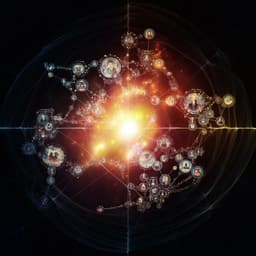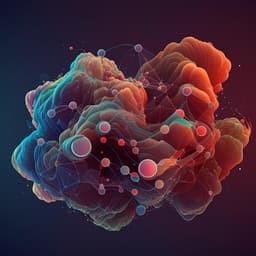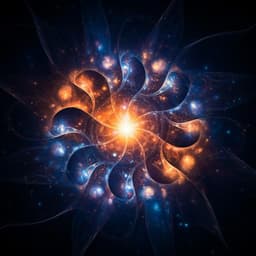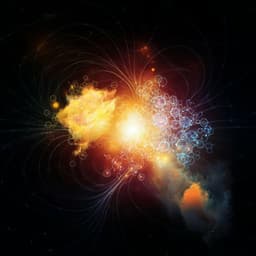
Medicine and Health
Psilocybin desynchronizes the human brain
J. S. Siegel, S. Subramanian, et al.
Experience the transformative power of psilocybin in this groundbreaking study conducted by a team of experts from leading institutions. Discover how a single dose can create profound brain changes, disrupt connectivity, and potentially offer therapeutic benefits, reshaping our understanding of psychedelic medicine.
Playback language: English
Introduction
Psychedelic drugs, particularly psilocybin, have shown promising therapeutic effects in treating depression, addiction, and anxiety. A single high dose of psilocybin leads to rapid and sustained symptom relief, suggesting potent acute and persistent neurobiological changes. Animal models demonstrate psilocybin-induced neuroplasticity, but the relationship between human brain network changes and the subjective and lasting effects of psychedelics remains unclear. This study aimed to investigate these relationships using a longitudinal, individual-specific approach to track brain changes before, during, and after psilocybin administration, comparing them to the effects of methylphenidate (a stimulant used as a control). Understanding the impact of psychedelics on human brain networks is crucial for elucidating their therapeutic mechanisms. Previous research has indicated that psilocybin alters glutamate signaling, glucose metabolism, electrophysiological signals, and hemodynamic fluctuations, but the precise drivers of these acute changes, particularly in subcortical regions, and the persistent effects on relevant brain circuits, remain to be fully characterized. The default mode network (DMN), particularly its interactions with the hippocampus, is a key area of interest due to its involvement in self-perception, space, time, and its association with depression symptoms. Precision functional mapping, with its focus on dense repeated fMRI sampling, offers a powerful tool to reveal the time course of individual-specific brain changes, accounting for inter-individual variability and leveraging the high stability of networks within individuals.
Literature Review
Existing research highlights the acute effects of psilocybin on brain activity, including increases in glutamate signaling and glucose metabolism, decreases in electrophysiological signal power and hemodynamic fluctuations, and reduced segregation between functional networks. However, the drivers of these changes, especially in subcortical areas, are not fully understood. Studies examining persistent effects have yielded mixed results. Preclinical research in rodents suggests that psilocybin alters neuronal communication in 5-HT2A-rich regions and induces persistent plasticity-related phenomena, including synaptogenesis in the medial frontal lobe and anterior hippocampus, which are thought to contribute to its antidepressant effects. However, limitations in rodent models and imperfect homology to the human 5-HT2A receptor limit the generalizability of these findings. In humans, increased functional connectivity (FC) between the hippocampus and DMN has been associated with depression symptoms, while decreased FC has been linked to treatment response. These 5-HT2A receptor-rich regions are key candidates for mediating the antidepressant effects of psychedelics. The study builds upon previous findings on the effects of psilocybin on brain networks but utilizes a more sophisticated and detailed approach to assess acute and persistent changes in a longitudinal setting.
Methodology
This study employed precision functional mapping using dense, repeated functional magnetic resonance imaging (fMRI) sampling. Healthy young adults (n=6) received 25mg of psilocybin and 40mg of methylphenidate (MTP) 1-2 weeks apart. Participants underwent approximately 18 fMRI sessions per person, including pre-drug baseline scans, scans during and after drug administration, and follow-up scans at 6-12 months. Dense predrug sampling established baseline variability. Functional connectivity (FC) changes were calculated across cortical and subcortical structures. The subjective psychedelic experience was assessed using the 30-item Mystical Experience Questionnaire (MEQ30). To examine the latent dimensions of brain network changes, multidimensional scaling (MDS) was performed on the parcellated FC matrices. Normalized global spatial complexity (NGSC), a measure of spatial entropy, was used to quantify brain signal synchrony. Participants also performed a simple auditory-visual matching task during some scans to investigate the influence of task states on psilocybin-driven brain changes. Persistent effects were analyzed by comparing FC changes 1-21 days post-psilocybin to pre-psilocybin baselines. Statistical analyses included linear mixed-effects (LME) models and permutation testing to account for individual variability. Extant datasets from intravenous psilocybin and LSD studies were also analyzed to assess the generalizability of findings.
Key Findings
Psilocybin acutely caused profound and widespread brain FC changes, predominantly in association networks and subcortical regions including the thalamus, basal ganglia, cerebellum, and anterior hippocampus. These effects were significantly larger than those of MTP, exceeding them by more than threefold. Psilocybin-associated FC changes were greatest within the DMN. Individual differences in FC changes strongly correlated with the intensity of the subjective psychedelic experience (r=0.81), particularly the sense of transcendence of time and space. Multidimensional scaling revealed a 'psychedelic dimension' separating psilocybin from other conditions, characterized by reduced segregation between the DMN and other typically anticorrelated networks. This effect generalized across psychedelic drugs (psilocybin and LSD). Psilocybin increased whole-brain and regional spatial entropy (NGSC), indicating desynchronization of brain activity, which correlated with the subjective experience. This desynchronization was largest in the association cortex and spatially corresponded to 5-HT2A receptor density. Task engagement significantly reduced the magnitude of psilocybin-associated network disruption and desynchronization, consistent with the 'grounding' principle in psychedelic therapy. Persistent effects were observed in the 3 weeks post-psilocybin, with a significant decrease in FC between the anterior hippocampus and DMN. This decrease was localized to the anterior hippocampus and returned to baseline by the 6-12 month follow-up, although with limited statistical power due to a smaller sample size.
Discussion
The study's findings strongly suggest that psilocybin's effects on the brain involve a widespread desynchronization of neural activity across multiple spatial scales, consistent with previous micro-scale recordings of neuronal activity. This desynchronization, particularly within the DMN and its interaction with the hippocampus, explains the profound changes in perception and consciousness reported by participants. The significant correlation between brain desynchronization and the intensity of the mystical experience highlights a potential neurobiological mechanism underpinning these subjective effects. The reduction in psilocybin-induced changes during task performance provides crucial insights into the context-dependent effects of psilocybin and supports the therapeutic strategy of grounding in psychedelic-assisted psychotherapy. The persistent decrease in FC between the anterior hippocampus and DMN, a region linked to self-perception and the present moment, may be a neurobiological correlate of the lasting therapeutic benefits of psilocybin, potentially reflecting increased neural plasticity. These results bridge micro- and macro-scale observations, highlighting desynchronization as a key mechanism.
Conclusion
This study demonstrates that psilocybin profoundly disrupts brain functional connectivity by causing widespread desynchronization, particularly within the default mode network and its interaction with the hippocampus. This desynchronization correlates strongly with the intensity of the subjective psychedelic experience and is reduced by task engagement. Persistent changes in hippocampal-DMN connectivity suggest a potential neuroanatomical basis for the long-term therapeutic effects. Future research should focus on investigating these mechanisms in clinical populations with depression and other psychiatric disorders, and on developing more refined methods for measuring neurotrophic markers in the human brain to strengthen the link between network-level changes and cellular-level plasticity.
Limitations
The study used a small sample size (n=6), which limits the generalizability of the findings. The study focused on healthy volunteers; further research is needed to confirm these findings in patients with depression or other mental health conditions. While the 6-12 month follow-up showed a return to baseline in hippocampal-DMN connectivity, the limited sample size at this time point reduces the statistical power to detect small changes. Finally, the study focused on fMRI, and future studies could incorporate other neuroimaging techniques to gain a more complete understanding of the neurobiological mechanisms underlying psilocybin's effects.
Related Publications
Explore these studies to deepen your understanding of the subject.







